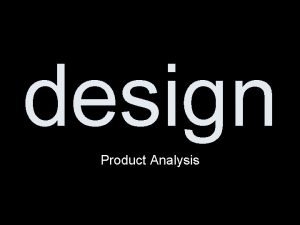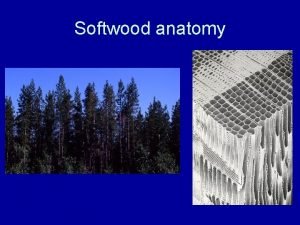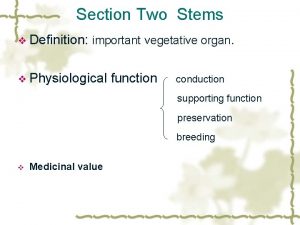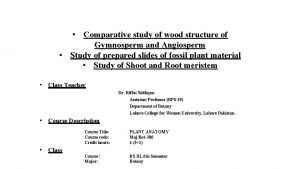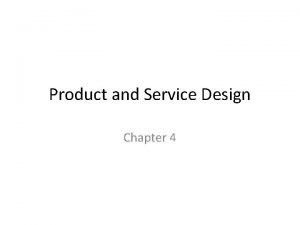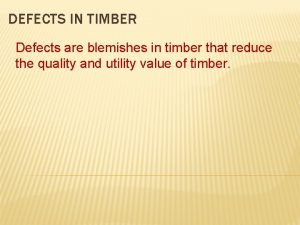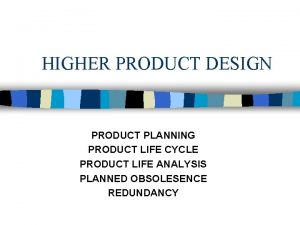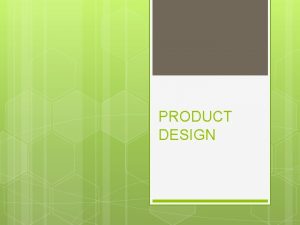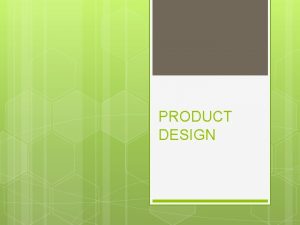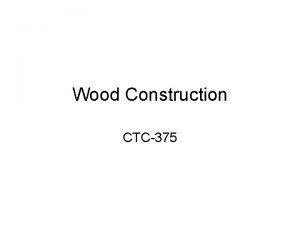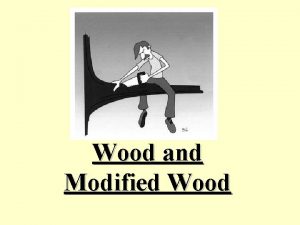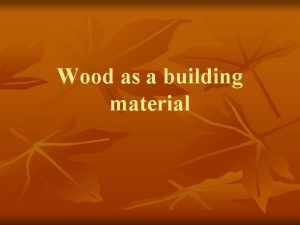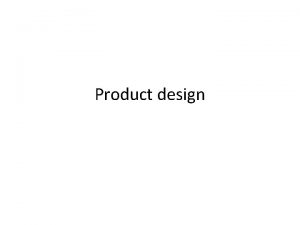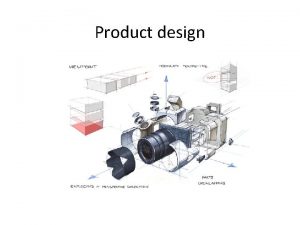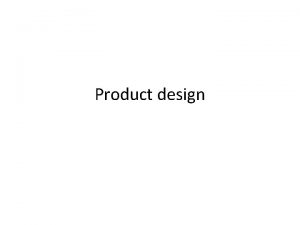WOOD Higher Product Design Wood Useful natural material


















- Slides: 18

WOOD Higher Product Design

Wood Useful, natural material Hard and fibrous in nature Made from cells made up of: § Cellulose(natural Resin) § Lignin (hard organic fibre) Natural polymer 3 classifications to wood: Hardwoods (slow growing 100 years from warmer climates) Softwoods (quick growing 30 years) Manufactured boards (man made composites) Each species of tree provides different timber that vary in colour, grain pattern, texture, strength, weight, stability, durability, cost and ease of working.

Hard woods Hardwoods - broadleaf, deciduous trees shed their leaves in winter or evergreen trees that keep their leaves throughout the year. Delicate with a shorter life span. Wood - stronger and in demand, more expensive

Hard woods Name Origin/colour properties uses Beech Europe/whitish pine to pale brown Strong, straight grained, even texture Furniture, turnery Elm Europe/light, reddish brown Tough, durable, difficult to work, Turnery, furniture, outdoor cross-grained use Oak Europe: light brown Japan: pinky-brown Strong, durable, hard, tough, tannic acid that corrodes steel leaving blue stains Ash Europe: pale cream and light brown Straight grained, coarse texture, Sports equipment, tool good elasticity, works and handles, cabinet making, finishes well laminating Mahogan y Central+South America, W. Indies, W. Africa/ pink reddish brown to deep brown Farily strong, medium weight, easy to work, durable, prone to warp Furniture, panelling, veneers Teak Burma, India/Golden Brown Hard, strong, durable, natural oil – water resistant, works well but blunts too quickly interior/exterior furniture, boat building Walnut Europe, USA/ yellow, brown, bronze, dark lines Attractive grain, cross grain makes finishing difficult Veneers, furniture, Furniture, flooring, boat building, veneers

Soft woods Softwoods - conifer trees that are cone bearing. They have leaves all year round, known as evergreen, Strong and withstand most weather conditions. Cheaper to buy and readily available most of year.

softwoods Name Origin/colour Properties/charac uses teristics Scots pine Northern Europe, Russia/ Cream, pale brown Straight grained but knotty, fairly strong, easy to work Red Cedar Canada, USA/dark, reddish colour Light, soft, weak Exterior shingles, natural oils make it cladding, sheds weather durable Parana Pine South America/ pale yellow with red/brown streaks Hard, straight, know-free, strong and durable, smooth finish, tends to warp, expensive Spruce (whitewood) Northern Europe, America/creamy white Fairly strong, small Construction, hard knots, general indoor Furniture, joinery, construction work Quality interior joinery: staircases, built in furniture

Manufactured Boards Strong, stable and economical Suited to mass produced furniture. Boards available in large sheets Beneficial to the environment – use up waste products from the sawmill that are made into particles Advantages: cheap, stable, thin veneers of expensive timers can be used to decorate, boards available in large sheets. Disadvantages: edges require ‘facings’, repair and maintence can be difficult.

Manufactured Boards Name Composition Properties/working characteristics Uses Plywood Thin veneers, cross laminated using odd number of layers Stable, strong and easy to machine Furniture, joinery, construction work Block board 25 mm strips glued together and faced with ply Stiff, heavy, good load-bearing Furniture, worktops, veneer groundwork Hard board Highly compresses wood fibres Cardboard like, weak Low cost furniture and brittle parts – cabinet backs, drawer bottoms MDF(Medium Density Fibreboard) Compressed wood fibres Easily machined, moulded and painted General shell/painted work, veneer ground Chipboard Compressed wood chips Stiffness and strength vary with density(thick) Furniture shell, good veneer ground

Joining Methods Joints Glue (Adhesive) Nails Screws

Adhesives Used to bind two pieces of material together Selection of which adhesive depends on purpose of product and material to be joined. Wood glue join timber products Some will allow for repositioning and adjustment Others can bond straight away. Adhesives will not usually bond to greasy or wet surfaces

Types of adhesives for woods PVA glue(polyvinyl acetate) Mostly used wood glue. Sold ready mixed Strong and doesn’t stain Excess wipes off with damp cloth Light cramping required Seal edges of MDF before painting Epoxy Resin Two part adhesive for unlike materials Bond glass, ceramics, wood, metal and thermosetting plastics Mixing resin triggers chemical reaction that sets adhesive Waterproof, good gap filler and electrical insulator Restricted to small scale applications as cost are high Not suited to thermoplastics

Types of screws COUNTERSUNK - SLOT HEAD: This can be used for general woodworking for example fitting hinges to doors. Because the screw is countersunk it can be tightened 'flush' to the surface of the material. ROUND HEAD SCREW: These are used for fixing pieces of material together where countersunk holes are not being used. Round head screws can look quite decorative especially if they are made of brass. POZIDRIV HEAD: Used with special screw drivers which will not slip when pressure is applied. This is ideal when using screws in corners or confined spaces.

Types of screws (contd) RAISED HEAD SCREW: Used to fit door handle plates and decorative features that must look good. CHIPBOARD SCREWS: The thread on this type of screw extends all the way along the length. It is best used with chipboard SELF-TAPPING SCREWS: these are normally used to cut a thread in metal. A hole is drilled in the metal, a fraction smaller than the width of the screw. The self-tapping screw is then turned into the hole cutting a thread.

Types of nails ROUND WIRE NAIL - This is used for general work. It is not attractive in shape and it can split wood when hammered in position OVAL WIRE NAIL - This is a long nail and care must be taken when it is hammered into the wood. It is unlikely to split the wood. LOST HEAD NAIL - This is ideal if it is necessary to hide the head of the nail as a punch can be used to hammer the head beneath the surface level. PANEL PIN - A very popular way of joining woods although glue is usually included as part of the join. TACK - Can be used for fixing textile materials to wood for example, fixing upholstery to furniture. HARDBOARD PIN - The diamond shaped head is hidden when used in materials like hardboard

Joints Halving joint Mortise and Tenon Bridle Joint Dove tail Finger Cross having

Knock down fitting Can be put together easily, normally using only a screw driver, a drill, a mallet/hammer and other basic tools. Temporary joints - many used to permanently join together items such as cabinets and other pieces of furniture that are purchased in a flat pack.

Knock down fittings PLASTIC CORNER BLOCK (FIXIT BLOCKS): NATURAL WOOD FITTING (SQUARE SECTION BATTEN): The corner block is pressed against the two pieces of material (normally wood based). Screws are used to fix the block into position. This type of joint is used to fit modern cabinets such as those found in a kitchen. It is a relatively strong joint although it has the advantage that it can be dismantled using a screwdriver. A piece of material such as pine can be drilled and screws can be passed through these holes. This gives a cheap and effective knock-down joint. The screws are normally countersunk into the knock-down fitting. RIGID JOINT: These are normally molded in plastic which makes them strong. Screws pass through the four holes which hold the sides at each corner firmly together.

Knock down fittings TWO BLOCK FITTING (LOK-JOINTS): These are made from plastic. A bolt passes through the first fitting into the thread of the second. As the bolt is tightened it draws the two fittings together. The pins help keep the fitting straight. This gives a very strong joint and it can be dismantled using a screwdriver. CAM LOCKS: The disk fits into a recess in the first side of the cabinet. It rotates by inserting a screwdriver into the slot in its side. The shaft is screwed into the second side of the cabinet. The collar of the shaft is passed through the hole in the second slot in the disk. When the disk rotates the shaft is locked in position. This keeps both sides of the cabinet locked together. SCAN FITTINGS These are strong enough to be either permanent or temporary joints. The cylinder is inserted into the first side of a cabinet in a pre-drilled hole. The screw is then pushed through the hole in the second side until it meets the cylinder. It can then be tightened with a
 Useful materials
Useful materials Why is product analysis useful to a designer
Why is product analysis useful to a designer Softwood anatomy
Softwood anatomy Early and late wood difference
Early and late wood difference Angiosperm wood vs gymnosperm wood
Angiosperm wood vs gymnosperm wood Wood sawed wood old tongue twister
Wood sawed wood old tongue twister Wood wood teenager
Wood wood teenager What does product and service design do
What does product and service design do Chapter 18 renewable energy
Chapter 18 renewable energy Product and quotient rules and higher order derivatives
Product and quotient rules and higher order derivatives Basic geometric features of symbology
Basic geometric features of symbology Idle time meaning in cost accounting
Idle time meaning in cost accounting Pop culture examples
Pop culture examples Non material culture examples
Non material culture examples All groups create norms to enforce their cultural values.
All groups create norms to enforce their cultural values. Examples of artificial defects
Examples of artificial defects Cosphaderm la-t
Cosphaderm la-t Natural hazards vs natural disasters
Natural hazards vs natural disasters Natural capital
Natural capital

